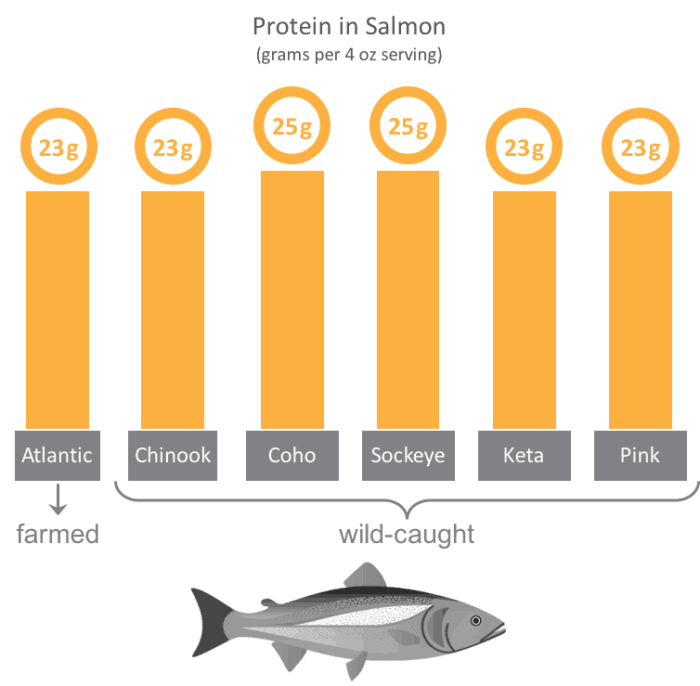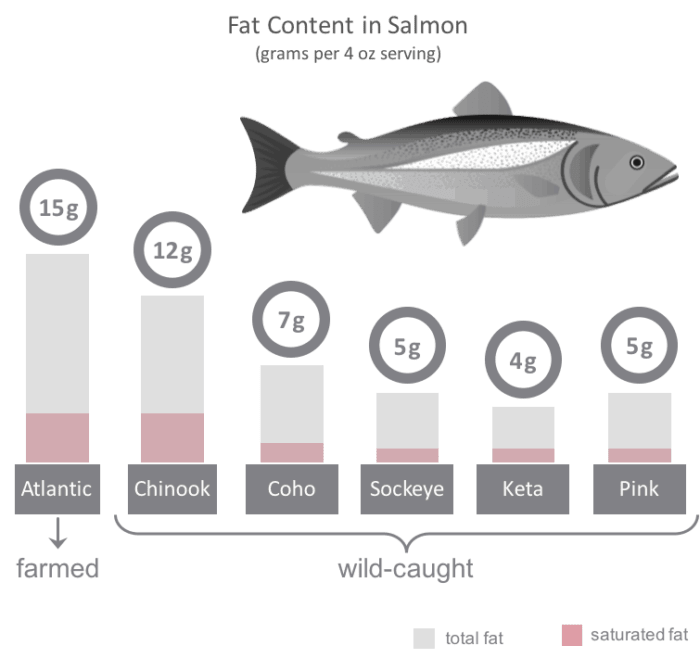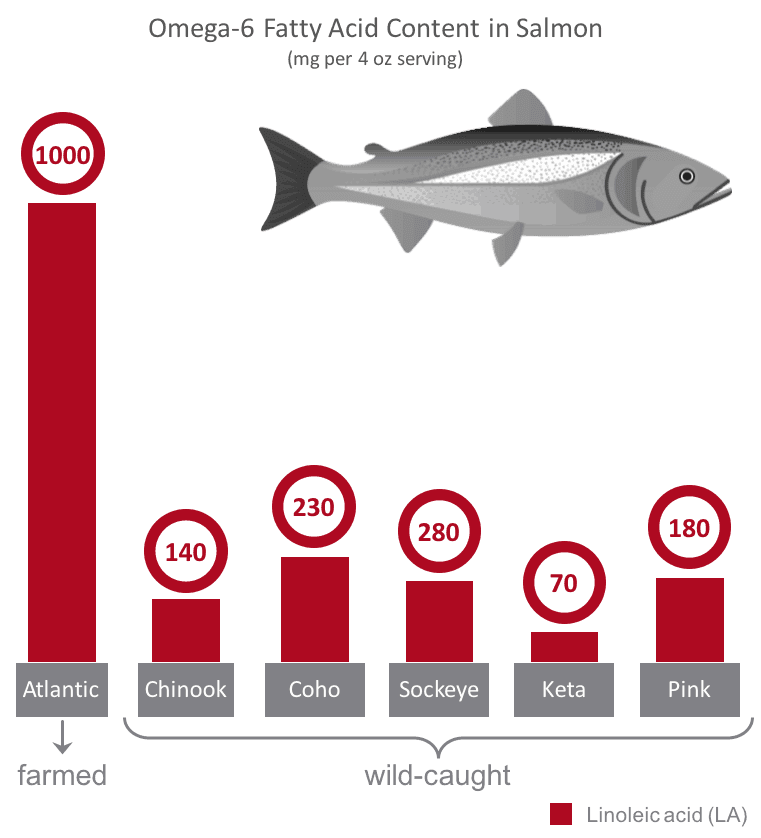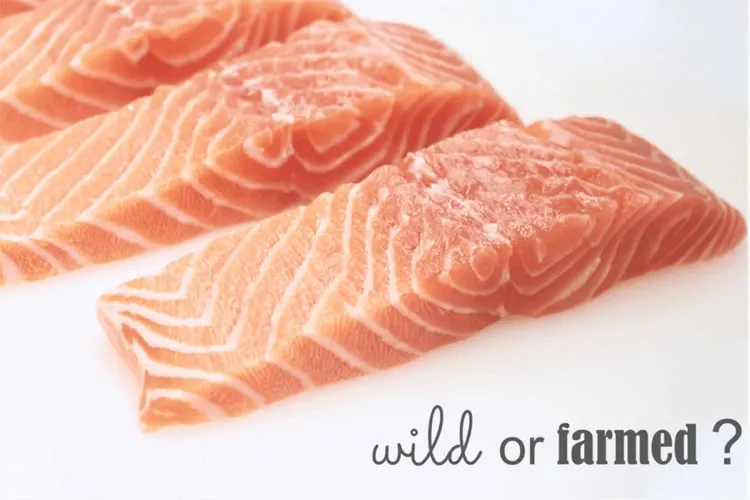We know eating fish is part of a healthy diet. But when it comes to salmon, is wild salmon the only healthy option? Is farmed salmon also a healthy choice?
Back in the early 2000s, many experts recommended avoiding farmed salmon because of high levels of toxic chemical contaminants and environmental concerns.(1,2) Should we still avoid eating farmed salmon? This article will cover the many differences, and few similarities, between farmed salmon and wild salmon.
How to identify farmed and wild salmon
Generally speaking, Atlantic salmon is farmed and Pacific salmon is wild-caught.
There are multiple types of predominantly wild-caught Pacific salmon. The taste, color, and nutritional profile of wild-caught salmon vary widely.
Types of wild salmon include:
- Chinook (King)
- Coho (Silver)
- Sockeye (Red)
- Keta (Chum)
- Pink (Humpback)
Wild salmon will usually be labeled at a store or restaurant because it can be sold for a higher price than farmed salmon.
Please note that some Chinook and Coho salmon can be farm raised, mostly from New Zealand and Chile, so read labels if you are looking for wild-caught fish.(3)

What do wild and farmed salmon eat?
When evaluating foods from animal sources, it is important to understand what they eat. As Michael Pollan wrote in In Defense of Food: An Eaters Manifesto, “You are what you eat eats.”(4)
Wild-caught salmon eat smaller fish and krill
Wild salmon are predatory animals that eat krill and other small fish. Krill are small crustaceans at the bottom of the food chain that feed on phytoplankton.(5)
Krill and the fish that eat them are rich in omega-3 fatty acids and lower in chemical contaminants (more on those later in this post).
Farmed salmon eat whatever they are fed
Farmed salmon food typically contains fish meal, fish oil, processed food by-products (corn, wheat, soy), animal by-products, and ingredients to color the salmon flesh.(1,6)
Because farmed salmon are often fed fish meal and fish oil from fish higher on the food chain, they tend to have higher levels of chemical contaminants than wild salmon.(1)
Nutritional differences between farmed and wild salmon
All salmon is a good source of lean protein.
On average, 4-oz serving of salmon provides 24 grams of protein.(8) The 2015-2020 Dietary Guidelines for Americans recommends eating two to three 4-oz servings of fish a week.(9)
A 4-oz serving is about the size of an adult palm.(10)

Fat content in farmed and wild-caught salmon
Farmed Atlantic salmon contain almost twice as much fat as wild-caught Pacific salmon, with the exception of Chinook salmon.(3)
Did you know that not all fats are unhealthy? Check out our post on the latest expert recommendations when it comes to which fats are healthy and how much fat we should eat.

Why are farmed salmon so fatty? It is because farmed fish live in enclosures with limited activity.
By contrast, wild-caught salmon swim many hundreds of miles in their lifetime.(1)
Farmed Atlantic salmon and chinook salmon also contain almost three times more saturated fat than other wild-caught salmon.
However, at 3.5 grams of saturated fat per 4-oz serving, this is still much lower than the 6.5 grams of saturated fat in a 4-oz hamburger.(8)
Fatty acid content in farmed and wild salmon
How much omega-3 fatty acid is in wild and farmed salmon?
Salmon is an excellent source of omega-3 fatty acids, a class of essential fatty acids we can only obtain from food.
Diets rich in omega-3 fatty acids are associated with better health, though most of the studies evaluating omega-3 fatty acids are observational.(11)
The NIH provides a good overview of omega-3 fatty acids and their health benefits.(4)
The chart below summarizes the omega-3 fatty acid levels in wild and farmed salmon.(8)
Just like other nutritional levels, the exact amount of omega-6 fatty acid in a particular salmon will vary by season and farming conditions, if applicable.

Farmed salmon and Chinook salmon are exceptionally high in omega-3 fatty acids due to their higher fat content. However, all types of salmon are considered a good source of omega-3 fatty acids.
Eating a 4-oz serving of any salmon provides an adult with somewhere between two to almost ten times the daily recommended intake of DHA and EPA set by the World Health Organization.(12)
How much Omega-6 fatty acid is wild and farmed salmon?
Omega-6 is a essential fatty acid found predominantly in vegetable oils. All species of wild-caught salmon have low levels of omega-6 fatty acids because they eat small fish and krill.
However, farmed salmon contain high amounts of omega-6 fatty acid because their feed contains vegetable oils from corn, wheat, soy, and other by-products of processed food.(14)
The below chart summarizes omega-6 fatty acid levels in various types of salmon.(3)
Just like other nutritional values, the exact amount of omega-6 fatty acid in a particular salmon will vary by season and farming conditions, if applicable.

Is the omega-6 fatty acid in farmed salmon unhealthy?
Some research indicates that omega-6 fatty acids are pro-inflammatory. (For more information, check out this post on anti-inflammatory foods and pro-inflammatory foods)
However, the American Heart Association (AHA) reviewed the available scientific literature and concluded that “aggregate data from randomized trials, case-control and cohort studies, and long-term animal feeding experiments indicate that the consumption of at least 5% to 10% of energy from omega-6 polyunsaturated fatty acids reduces the risk of CHD relative to lower intakes.”(13)
Does this mean you should avoid farmed salmon because of the elevated omega-6 fatty acid levels? Maybe. If you are trying to eat an anti-inflammatory diet low in omega-6 fatty acids, it is best to choose wild salmon.
Chemical contaminants in wild and farmed fish
You may have seen a recommendation that pregnant women or children should limit their consumption of king mackerel, shark, swordfish, and tilefish.(15)
This warning is based on high levels of chemical contaminants, like methyl mercury and polychlorinated biphenyls (PCBs). Many of these contaminants do not break down and are persistent in the environment in spite of being banned for at least four decades. Unfortunately, some types of fish are the major dietary source of methyl mercury and PCBs.(15)
Because these contaminants are fat soluble, they can build-up in whatever eats them. Fish that eat high on the food chain (i.e. other fish only slightly smaller than themselves) are consuming, and storing, more contaminants than fish that eat krill or other small sea life.
With that said, the Dietary Guidelines for Americans as well as guidelines from the Food and Drug Administration (FDA) and Environmental Protection Agency (EPA) agree that the benefits of eating fish outweigh the potential health risks from chemical contaminants.(9,10)
Is there a difference in contaminant levels between wild and farmed salmon?
In 2004, a study published in the journal Science showed that farmed salmon contained higher levels of PCBs, dioxins, and many other persistent chemicals when compared with wild-caught salmon.(16)
The study also showed that the farm location had a huge impact on chemical contamination of salmon. Salmon farmed in Europe had the highest levels of contaminants compared to salmon farmed in North and South America.
The chemical contamination in salmon is from the forage fish (i.e. fish meal and fish oil) fed to farmed salmon.
Does farmed salmon still contain more chemical contaminants than wild salmon?
It would be reasonable to assume the shift to a predominantly vegetable-based farmed salmon feed should result in a decrease in chemical contaminants. Unfortunately, recent data is not available for chemical contaminants levels in wild and farmed salmon.
In 2013, the USDA added salmon to its annual Pesticide Data Project to analyze the residual pesticide levels of common agricultural pesticides and environmental contaminants.(17) However, the analysis pooled both wild-caught and farmed salmon samples (both processed and raw), making the results essentially meaningless.
Buy fish from grocery chains that test for chemical contaminants
How do you know if your salmon is low in chemical contaminants? Buy wild-caught salmon or talk to your grocer.
Some grocery chains (such as Whole Foods) only sell farm-raised salmon that tests low for chemical contaminants.(18)
Antibiotic use in farmed salmon
Antibiotic use is another consideration with farmed salmon. Farmed fish are raised in crowded enclosures that promote disease, necessitating the frequent use of antibiotics and other medicines.
When measured, the residual antibiotics levels in farmed salmon are within regulatory limits.(7) However, the health impacts of chronic, low-level exposure to antibiotics and other medicines, have not been evaluated.
Antibiotic use in salmon farming is especially concerning because of the development of antibiotic resistant bacteria. According to the U.S. National Academy of Medicine, “there is a direct link between antibiotic use on farms and the spread of antibiotic resistant bacteria to human populations.”(19,20)
In the United States, farm animals are given four times more antibiotics than people. Read more about the concerns with using antibiotics in farming and the development of antibiotic resistant bacteria.
Purchase salmon raised without antibiotics
Buy wild-caught salmon or farmed salmon raised without antibiotics. Some supermarket chains, such as Whole Foods Market, only sell farmed salmon raised without antibiotics.
Other stores, such as Costco, sell a variety of different types of farmed salmon, and with a “raised without antibiotics” option generally available.
Country of origin may indicate whether farmed salmon was raised with antibiotics. Almost all farmed salmon from Norway is raised without antibiotics.(7)
Chile, on the other hand, has been found to use excessive levels of antibiotics in aquaculture.
In 2015, Norway used 0.17 grams of antibiotics per ton of farmed salmon while Chile used 660 grams antibiotics per ton of fish.(21)
Which salmon is the healthiest?
All salmon is an excellent source of both lean protein and omega-3 fatty acids. When shopping for salmon there are a few options that are the healthiest.
1. Wild salmon is a healthy choice
Wild-caught salmon is lower in omega-6 fatty acids, chemical contaminants, and is free of antibiotic residues.
When wild salmon is in season, consider stocking up and freezing some. If fresh wild salmon is out of season or prohibitively expensive, consider buying frozen wild salmon.
Remember, it is still important to read the ingredient list on frozen wild salmon! Some suppliers add preservatives or other additives ahead of freezing the wild salmon to help it “retain moisture.”
2. Farmed salmon raised without antibiotics
To find farmed salmon raised without antibiotics, read labels or speak directly with the fishmonger / butcher at your grocery store.
In general, if farmed salmon is not labeled “raised without antibiotics”, you don’t want to buy it. To learn more about which grocery stores sell healthier farmed salmon, check out our comprehensive guide to buying healthy farmed salmon.
3. Organic farmed salmon, if available
Organically raised farmed fish is sold in Canada and Europe. The United States does not currently certify organic farmed fish, but the USDA has plans to do so in the future.(22) As with other organic animal products, organic farmed salmon is raised with 100% organic feed. Organically raised salmon eat only non-GMO grains free of organophosphate or glyphosate residue.(23) Organically raised farmed salmon are not treated with antibiotics. While any animal being raised under organic certification may be treated with antibiotics if it is sick, it can not be sold with the “organic” label.
Finally, remove the salmon skin!
Removing the skin from salmon before eating is one easy way of reducing exposure to chemical contaminants. In fact, a study by researchers at the University of Toronto showed that removing the skin before eating reduced exposure to contaminants by up to 37%.(24)
When cooking salmon, cook it in a way that allows the fat to drain off (grill, broil, poach) and remove the fatty (dark) areas prior to eating.
Pin this article for later:
References:
- What We Eat, Marion Nestle, 2006 (link)
- Why farmed salmon is becoming a viable alternative to wild-caught, Tamar Haspel, The Washington Post (link)
- Seafood Watch App, Monterey Bay Aquarium (link)
- In Defense of Food, Michael Pollan, 2008 (link)
- Krill, Wikipedia Website (link)
- Table of Atlantic Salmon Feed Meal Ingredients, Food and Agriculture Organization of the United Nations Website (link)
- Vaccinating Salmon: How Norway avoids antibiotics in fish farming, World Health Organization Website (link)
- USDA National Nutrient Database for Standard Reference, USDA Website (link)
- Dietary Guidelines for Americans, 2015-2020, Eighth Ed. (link)
- 2017 EPA-FDA Advice on Eating Fish, FDA Website (link)
- Omega-3 Fatty Acids, National Institutes of Health Website (link)
- Interim Summary of Conclusions and Dietary Recommendations on Total Fat & Fatty Acids, 2008, World Health Organization Website (link)
- Omega-6 Fatty Acids and Risk for Cardiovascular Disease, Circulation, 2009, 119: 902-907 (link)
- Survey of n-3 and n-6 polyunsaturated fatty acids in fish and fish products. Lipids in Health and Disease, 2012, 11:144 (link)
- Fish and polychlorinated biphenyls (PCBs), Mayo Clinic Website (link)
- Global Assessment of Organic Contaminants in Farmed Salmon, Science, 303, 226-229 (link)
- USDA PDP 2013, Salmon Special Project (link)
- Quality Standards for Farm Seafood, Jan 2014, Whole Foods Market Website (link)
- The Challenge of Antibiotic Resistance, Stuart Levy, Scientific American, 1998 (link)
- Antibiotic Resistance in Humans and Animals, National Academies of Science Website (link)
- With record antibiotic use, concerns mount that Chile’s salmon farms brewing superbugs, Allison Guy, Oceana Website (link)
- USDA Guidance on Organic Aquaculture, USDA website (link)
- Organic Production Systems, Aquaculture. CAN/CGSB-32.312-2018 . Standards Council of Canada Website (link)
- Effects of skin removal on contaminant levels in salmon and trout fillets, Science of the Total Environment, 443: 218-225, Jan 2013 (link)
Originally published in June, 2017, this post has been updated to enhance readability, add additional content, and to ensure up-do-date references.


Marit
Tuesday 13th of July 2021
Thanks for listing references and for this article. I just got some Whole Foods farmed salmon and the taste was amazing. I was wondering how "bad" it was compared to our usual wild caught.
Alexandra
Tuesday 27th of April 2021
Excellent job Meredith! This article was really helpful! Thank you!
Ruth Whetsel
Friday 7th of February 2020
Very helpful article. I'll be re-reading it. Thank you. Ruth Whetsel
Meredith
Wednesday 19th of February 2020
You are most welcome Ruth - thank you for your kind comment!
Siva
Wednesday 9th of January 2019
Excellent info. Thanks a lot
Meredith
Sunday 13th of January 2019
You are welcome Siva!
Paul Janson
Saturday 30th of December 2017
Excellent post, thanks for doing all this legwork. I found a link to the 2004 Science article that isn't behind a paywall -- https://www.preventivecare.com/shared/pdf/GlobalAssessmentSalmon-Hites.pdf
Meredith
Saturday 30th of December 2017
Thank you Paul! And thank you for the link to the 2004 Science article... I have updated the link in my post.